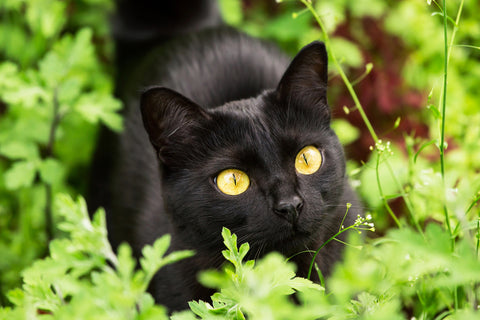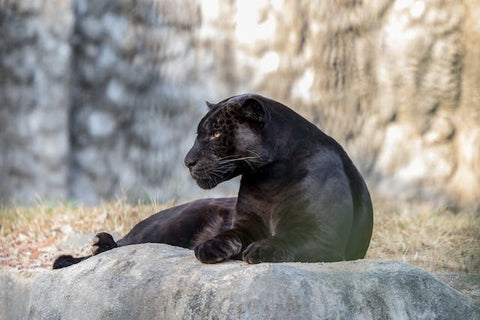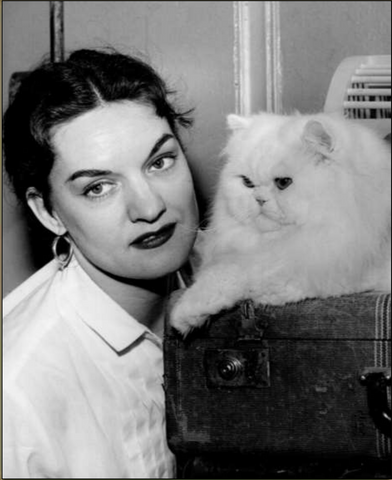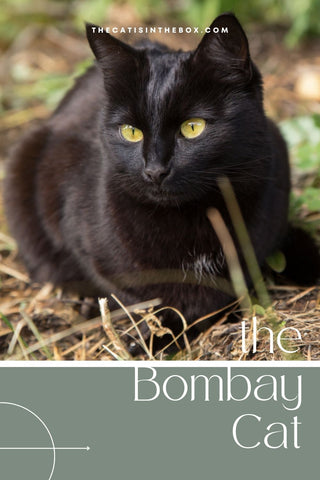The Bombay Cat

The black-lacquer coat will be the thing you’ll notice the first time you meet a Bombay cat.
The inky-ness is so deep and so complete, and the glossiness so lustrous, that it’s mesmerizing.
But you’ll snap right out of your reverie the moment you get close enough for a greeting. A Bombay cat, unaware of her captivating beauty, will be tangled in your ankles, or climbing on your shoulder in no time at all, wondering why you two aren’t already BFFs.
The Bombay cat may be beautiful, but the fact that he’s a wonderful, extroverted goofball who has never met a stranger, makes this cat breed really special.
The Bombay cat: it’s complicated
Before we can even begin talking about the Bombay cat, there are some Bombay “facts,” misconceptions, and potential confusions that we should address first.
The Bombay cat is not from Bombay

First things first: there is no place called Bombay today.
Today, the city once called Bombay during its colonization by Britain, is now referred to by its Hindu name, Mumbai. Mumbai is India’s most populous city, and its financial center.
Names can be political and Mumbai is no exception. There’s still Bombay/Mumbai controversy in some circles.[1] But that’s a conversation for another blog.
None of this has anything to do with the Bombay cat, who actually came from Kentucky, in the United States.
The Bombay cat was probably NOT designed to look like a panther

This raven-hued cat goes by several nicknames inspired by black wild cats, including fireside panther, parlor panther, and mini panther.
Personally, aside from the color, I don’t see a resemblance. But that’s irrelevant. The question is whether it was the intention of the breed’s founder to create a diminutive panther.
She may have – at first. The breed’s founder, Nikki Horner (whom I describe in more detail below), may have attempted to create a house panther in the late 1950s, but was dissatisfied with the results and gave up.
When she eventually mated a black, copper-eyed American Shorthair to a Burmese, it was for the express purpose of addressing the problem of inbreeding in Burmese cats. Horner was a Burmese breeder first, and she is quoted in the August 1965 issue of Cats Magazine regarding the creation of an American Shorthair/Burmese hybrid:
“The purpose of these breedings is to breed a Burmese as the standard calls for and at the same time increase fecundity and offset lethal genes so evident in today’s inbred Burmese.”[2]
Read all about the American Shorthair and the Burmese cat in these posts.
(A quick word about panthers)
By the way, there’s no such thing as a panther. It’s a generic term used to describe large wild cats who happen to be black.
The term black panther could be used to describe black-coated leopards (Panthera pardus) from Africa and Asia. Black panther could also be used to describe jaguars (Panthera onca) of Central and South America.[3]
Sometimes the term panther is used to describe bobcats, lynx, jaguarundis, tigers, and pumas with dark coats.[4]
But there is no single animal that is called panther.
There are two different cat breeds called Bombay cats

Did cat breeders run out of names? It appears so.
There are actually two different cat breeds who go by the name Bombay, and aside from the fact that they are both black, they are different cats.
The Bombay cat recognized by cat breed registries CFA and TICA is the American version of the Bombay cat, and the breed I refer to in this post.
The European Bombay is really an Asian Self
There’s a cat breed recognized in Britain called the Asian, or Asian group, that is basically a European Burmese (which is different from an American Burmese…my head is spinning) but in different colors and fur types.
The Asian began as an accidental mating of a Persian cat with a European Burmese. The Asian group is basically a European Burmese, but in a wider variety of colors and hair lengths.[5]
The European Bombay is a solid-colored black Asian. “Self” is the term cat-fancy people use instead of “solid-colored.”
Except…the European Bombay isn’t like all the other Asians in the Asian group.
If all of the other Asians in the Asian group began as Persian/Burmese crosses, the European Bombay began as a Burmese/black domestic shorthair cross. Completely different.
And just to make sure you understand: the American Shorthair is not the same as a domestic shorthair.
The American Shorthair is a purebred cat, while the domestic shorthair is just a shorthaired mixed-breed cat.
What is the history of the Bombay cat?

The Bombay cat has a short history, but it starts with cat-crazy, publicity-seeking, runway model, TV game-show personality, cat breeder.
This cat breeder was Necolia Willoughby Slobodian Horner Shuttleworth, who, thankfully, went by the name Nikki Horner.
She loved cats from the very beginning. She began bringing home strays as a child, which her parents didn’t discourage. But they did leave the windows open so some of her growing collection could escape.
She became a kind of an accidental cat breeder when she got her first Siamese cat as a gift. The cat became very vocal when she went into heat, and Horner said that she bred her so that she could get some sleep at night.
She went on to become a renowned breeder of not only Siamese cats, but Persians, American Shorthairs, and Burmese. At any one point in her life, she had between 15 and 100 cats in the house, and took up modeling for Saks Fifth Avenue to help pay for her cat habit.
In her lifetime, Horner’s cats won at least 100 CFA Grand Championships and about 500 Best in Shows.[6]
Horner got interested in black cats after a black female kitten appeared in a litter of silver tabby American Shorthairs.
As described above, Horner may (or may not) have attempted to create a panther lookalike after the birth of this black American Shorthair. But the creation of the Bombay cat, an American Shorthair/Burmese hybrid, years later, sprung from her desire to expand the gene pool for the American Burmese breed.
The Bombay cat was accepted for registration in the Cat Fanciers’ Association (CFA) in 1970 and The International Cat Association (TICA) in 1979.
After the CFA accomplishment, Horner abruptly retired from cat breeding and sold her cattery.
She couldn’t stay away for too long, though. She resumed showing her Bombays again in the late 1980s.
What does a Bombay cat look like?

There are black cats and then there are Bombay cats.
Bombays are black everywhere, from the whiskers, down the roots of every single hair. Bombays have black skin, black lips, black nose leather, and black toe beans.
The black fur on this cat is close-lying and glossy. The eyes are always a shade somewhere between warm gold, copper, and bright orange, but never green.
The Bombay is a medium-sized cat, somewhere between 5 ½ to 11 pounds, more or less, but with a muscular build.
He has a distinctly round head with a short muzzle, and wide-set, medium-sized ears with rounded tips.
If you’ve ever met a Burmese cat, the Bombay is similar in build, but slightly more slender.
(Read all about black cats in this post.)
What is the personality of a Bombay cat?

You can’t help but think what a great idea it was to mix the easy-going nature of the American Shorthair, with the loving, social personality of the Burmese.
The Bombay cat loves everyone, from you to your kids, your guests, strangers at the front door, and all the other cats and dogs in your family.
This is a cat who wants to be perched on your shoulder while you’re cooking, on your lap while you’re reading the paper or watching TV, and on the floor goofing around with your kids. She’ll also be the first one to the front door when the bell rings.
This is not a cat who bonds to one particular person. The Bombay gets attached to everyone in the family. He can also be easily leash-trained and taught to fetch.
A Bombay will be thoroughly happy as an indoor cat, and will even thrive in a single-room apartment.[7]
The Bombay is just an easy-going kitty, with a lively, upbeat approach to life.
Is the Bombay a healthy cat?
The Bombay is a healthy cat who can be expected to live for 15 to 20 years.[8]
Potential health problems include:
Hypertrophic cardiomyopathy (HCM), which is the most common form of heart disease in cats. You can read more about HCM in this post.
Some Bombays suffer from nasal or sinus problems due to their short muzzles, including excessive tearing, and breathing difficulties.[9]
Love Pinterest? Here's a Pinterest-friendly pin for your boards!

Dawn LaFontaine is a lifelong animal lover who always seems to have a little pet hair in her keyboard. Her blog, Kitty Contemplations, helps cat guardians better understand and care for the special beings they share their lives and homes with. Her cat-products business, Cat in the Box, sells beautiful, well-made, and award-winning products that she designed to meet the biological needs of cats.
_______________
FOOTNOTES
[1] Taylor, Adam. “Mumbai or Bombay? A British Newspaper Reverts to a Colonial-Era Name.” The Washington Post, WP Company, 1 Dec. 2021, www.washingtonpost.com/news/worldviews/wp/2016/02/10/mumbai-or-bombay-a-british-newspaper-reverts-to-a-colonial-era-name/.
[2] Hartwell, Sarah. “PROMINENT POST-WW2 CAT FANCIERS - NECOLIA (NIKKI) WILLOUGHBY SLOBODIAN HORNER SHUTTLEWORTH (SHAWNEE CATTERY).” Prominent POST-WW2 Cat Fanciers - Nikki Horner, messybeast.com/retro-fanciers-horner.htm. Accessed 14 Nov. 2023.
[3] “Black Panther.” Encyclopædia Britannica, Encyclopædia Britannica, inc., 7 Nov. 2023, www.britannica.com/animal/black-panther-mammal.
[4] “Black Panther.” Encyclopædia Britannica.
[5] “Asian Cat.” Wikipedia, Wikimedia Foundation, 5 Oct. 2023, en.wikipedia.org/wiki/Asian_cat.
[6] Lawrence, Karen. “NECOLIA WILLOUGHBY SLOBODIAN HORNER SHUTTLEWORTH Shawnee Cattery.” CFA Foundation. https://cat-o-pedia.org/icons/NikkiHorner.pdf
[7] “Bombay Cat.” Wikipedia, Wikimedia Foundation, 29 Oct. 2023, en.wikipedia.org/wiki/Bombay_cat.
[8] “Bombay Cat.” Wikipedia.
[9] “Bombay.” Embrace Pet Insurance, 29 Mar. 2021, www.embracepetinsurance.com/cat-breeds/bombay.

